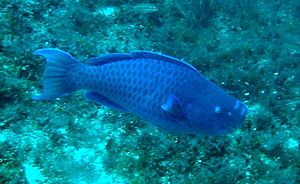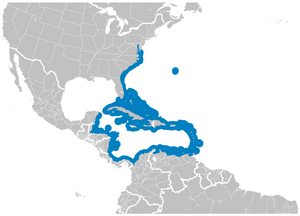Blue parrotfish facts for kids
Quick facts for kids Blue parrotfish |
|
|---|---|
 |
|
| Blue parrotfish in Madagascar Reef. | |
| Conservation status | |
| Scientific classification | |
 |
|
| Blue parrotfish range. | |
| Synonyms | |
|
The blue parrotfish (Scarus coeruleus) is a really cool fish that lives on coral reefs. It's part of the parrotfish family, known for their unique "beaks." You can find them in the warm, shallow waters of the western Atlantic Ocean and the Caribbean Sea.
Contents
What Does the Blue Parrotfish Look Like?
These fish are easy to spot because they are almost completely blue! When they are young, they might have a yellow spot on their heads. This spot usually fades away as they get older.
Size and Weight
Blue parrotfish are usually about 30 to 75 centimeters (1 to 2.5 feet) long. Some can grow much bigger, up to 1.2 meters (almost 4 feet) in length! A full-grown blue parrotfish can weigh around 9.1 kilograms (20 pounds).
Their Special Beak and Teeth
Like other parrotfish, they have a big, strong "beak." This isn't a real beak like a bird's, but their teeth are fused together to form a beak-like shape. They use this beak to scrape algae and tiny living things off rocks and corals. They also have special teeth in their throats, called pharyngeal teeth. These teeth help them grind up the bits of rock and coral they swallow, turning them into sand. This is why parrotfish are so important for making the white sand beaches you see!
How Blue Parrotfish Reproduce
During the summer, blue parrotfish gather together in groups to lay their eggs. The females release their eggs into the water. These eggs then float down to the seabed. After about 25 hours, the eggs hatch, and tiny baby parrotfish emerge!
Where Do Blue Parrotfish Live?
You can find blue parrotfish on coral reefs. They usually live in waters that are about 3 to 25 meters (10 to 80 feet) deep. Their home range stretches from Maryland in the United States, down to Bermuda, the Bahamas, and all the way to Brazil. They are also common throughout the West Indies. Young blue parrotfish often hide and grow up in beds of turtle grass.
What Do Blue Parrotfish Eat?
Blue parrotfish spend most of their day, about 80% of their time, looking for food. Their main diet is tiny organisms that live in the algae they scrape off rocks. They are also known as "sand-suckers" because they often search for food in the sandy areas around the reef. They suck up the sand to find small creatures hidden within it.
Are Blue Parrotfish Endangered?
The IUCN has listed the blue parrotfish as a species of "Least Concern." This means that they are not currently in danger of disappearing. They live in a very wide area and there are many of them. Even though some bigger fish are caught by fishermen, the total number of blue parrotfish seems to be stable. Many of their habitats are also protected in marine conservation areas.
See also
 In Spanish: Pez loro azul para niños
In Spanish: Pez loro azul para niños


